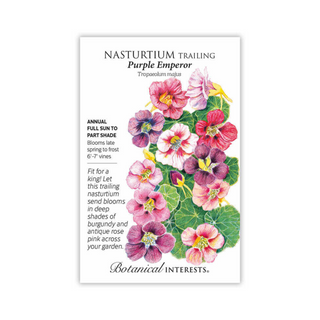
Description
Regal 'Purple Emperor' boasts deeply-veined petals in varying shades of purple that fade into lavender and dusty rose. This trailing variety is fairly drought tolerant, and would be perfect as a ground cover or in a hanging basket. Edible blossoms and leaves provide a peppery kick to salads, and are a beautiful garnish on desserts! Usually grown as an annual; perennial in USDA zones 10 and warmer. Rabbit and deer resistant.
Variety Info
- Family: Tropaeolaceae, Nasturtium family, contains more than 75 species of garden nasturtiums.
- Native: South America
- Hardiness: Frost-sensitive, tender perennial usually grown as an annual; perennial in USDA zones 10 and warmer.
- Exposure: Full sun to part shade
- Bloom Period: Late spring to frost
- Plant Dimensions: 6'–7' vines
- Variety Info: 2" blossoms that bloom burgundy purple and fade to lavender and rose pink.
- Attributes: Attracts Hummingbirds, Attracts Pollinators, Drought Tolerant, Deer Resistant, Rabbit Resistant, Good for Containers, Edible Flower
Sowing Info
- When to Sow Outside: RECOMMENDED. 1 to 2 weeks after your average last frost date. Mild Climates: Sow in fall for winter bloom. Ideal soil temperature for germination is 55°‒65°F.
- When to Start Inside: Not recommended. 2 to 4 weeks before your average last frost date. Roots sensitive to transplant disturbance; sow in biodegradable pots that can be directly planted in the ground.
- Days to Emerge: 7 ‒ 14 days
- Seed Depth: ½"–1"
- Seed Spacing: A group of 3 seeds every 8" – 12"
- Thinning: When 2" tall, thin to 1 every 8" – 12"
Growing Info
- Harvesting: Harvest leaves and flowers in the morning, if possible, when they are more hydrated and cooler, rather than later in the day.
- Special Care: Deadhead (remove spent blossoms) for optimum number of blooms and to prevent seed formation. Nasturtium may self-sow.
Description
Regal 'Purple Emperor' boasts deeply-veined petals in varying shades of purple that fade into lavender and dusty rose. This trailing variety is fairly drought tolerant, and would be perfect as a ground cover or in a hanging basket. Edible blossoms and leaves provide a peppery kick to salads, and are a beautiful garnish on desserts! Usually grown as an annual; perennial in USDA zones 10 and warmer. Rabbit and deer resistant.
Variety Info
- Family: Tropaeolaceae, Nasturtium family, contains more than 75 species of garden nasturtiums.
- Native: South America
- Hardiness: Frost-sensitive, tender perennial usually grown as an annual; perennial in USDA zones 10 and warmer.
- Exposure: Full sun to part shade
- Bloom Period: Late spring to frost
- Plant Dimensions: 6'–7' vines
- Variety Info: 2" blossoms that bloom burgundy purple and fade to lavender and rose pink.
- Attributes: Attracts Hummingbirds, Attracts Pollinators, Drought Tolerant, Deer Resistant, Rabbit Resistant, Good for Containers, Edible Flower
Sowing Info
- When to Sow Outside: RECOMMENDED. 1 to 2 weeks after your average last frost date. Mild Climates: Sow in fall for winter bloom. Ideal soil temperature for germination is 55°‒65°F.
- When to Start Inside: Not recommended. 2 to 4 weeks before your average last frost date. Roots sensitive to transplant disturbance; sow in biodegradable pots that can be directly planted in the ground.
- Days to Emerge: 7 ‒ 14 days
- Seed Depth: ½"–1"
- Seed Spacing: A group of 3 seeds every 8" – 12"
- Thinning: When 2" tall, thin to 1 every 8" – 12"
Growing Info
- Harvesting: Harvest leaves and flowers in the morning, if possible, when they are more hydrated and cooler, rather than later in the day.
- Special Care: Deadhead (remove spent blossoms) for optimum number of blooms and to prevent seed formation. Nasturtium may self-sow.

